Outsourcing to Czechia

How much does it cost to hire developers in Czechia?
Dec 2nd 25 - by Devico Team
Find out how much it costs to hire software developers in Czechia in 2025. Compare hourly rates, roles, and factors that impact pricing.
Hire
Hire by role
Hire Front-end developers
Hire Back-end developers
Hire Full-stack developers
Hire Android developers
Hire iOS developers
Hire Mobile developers
Hire AI engineers
Hire ML engineers
Hire Automation QA engineers
Hire Blockchain developers
Hire Data engineers
Hire Cloud engineers
Hire by skill
Hire JavaScript developers
Hire TypeScript developers
Hire Ruby on Rails developers
Hire React Native developers
Hire Flutter developers
Hire Golang developers
Hire React.js developers
Hire Python developers
Hire PHP developers
Hire .NET developers
Hire Java developers
Hire Laravel developers

Digital transformation
September 26, 2023 - by Devico Team
Summarize with:
Imagine having to pay your utility bills. You need to record the meter readings, then take the documents and indicators, go to the appropriate institution, and there, settle the bills. Quite complex and time-consuming, isn't it? This is where digital transformation comes into play, aiming to simplify routine tasks.
On the other hand, money talks. Is the digital transformation worth to be implemented? According to McKinsey Digital, large global companies have captured only 31% of the expected revenue lift and 25% of expected cost savings from digital and AI transformation. So to use or not to use, that’s the question. Another question is, what’s the digital transformation at all?
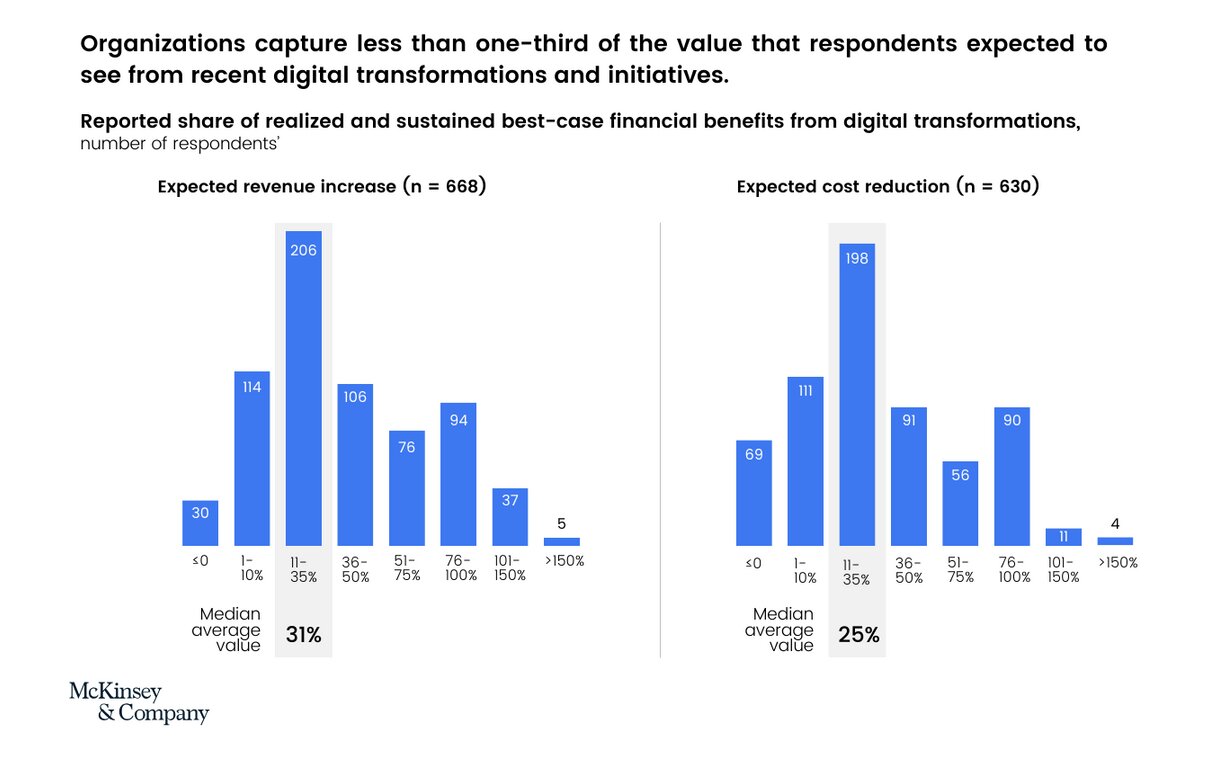
There are some discrepancies in understanding the terms: what digital transformation, digitization, and digitalization truly entail. In this article, you will learn about the distinctions between them, why digitizing the social sphere is crucial, and what has led to the accelerated transformation of nearly every aspect of our lives.
The term "digital transformation" has evolved into a catchall phrase that means different things to different people. There's a problem there. Digital transformation is essential for organizations to compete and, even more — to survive. To achieve success in a technology transformation, it's crucial for leaders to have a clear understanding of what it entails and to align their organization around a specific program. Without this clarity and alignment, success is unlikely.
McKinsey defines digital transformation as

For instance, transformation is the way we interact with the world. Digital passports, signing documents with a blink of an eye (and in the blink of an eye), paying utilities with a thumb tap — all of these can be considered part of this transformation.
The most common areas of digital transformation are customer experience, marketing, and sales. However, there is a growing focus on areas such as supply chain management, manufacturing, and human resources. If we are talking about GEOs, in the US, 72% of businesses have implemented some form of digital transformation, while in Britain, the figure is 65%, and in Europe, as a whole, it is 60%.
Beyond that, it's a culture shift that demands firms constantly challenging the status quo, experimenting regularly, and becoming comfortable with failure. This frequently entails abandoning long-standing business processes on which organizations were founded in favor of relatively fresh ones still being defined.
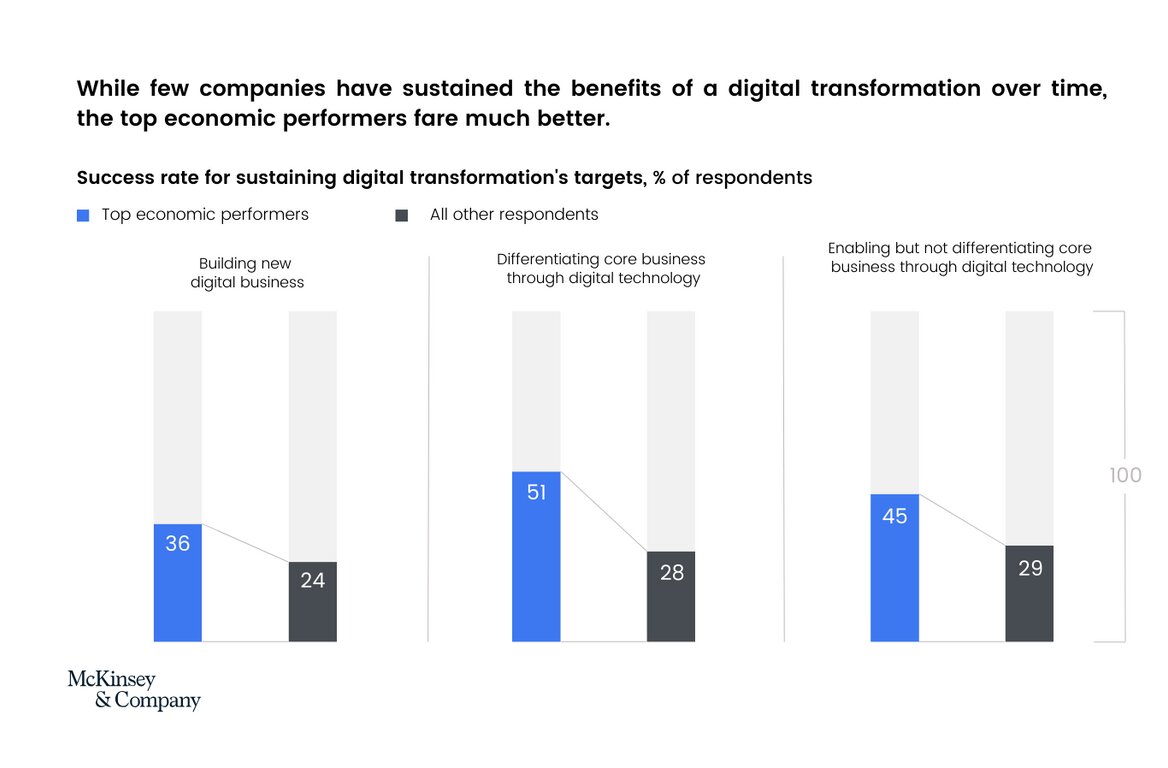
According to Jay Ferro, Clario's chief information and technology officer, digital transformation should begin with a problem statement, a clear opportunity, or an aspirational aim. "The "why" of your organization's digital transformation could revolve around, for example, improving customer experience, reducing friction, increasing productivity, or elevating profitability," Ferro says. "Or, if it's an aspirational statement, it might revolve around becoming the absolute best to do business with, utilizing enabling digital technologies that were unavailable years ago."
As we wrote above, there is some confusion about the definitions of terms. We do not pretend to be the ultimate institution, but we suggest defining exactly what each of the terms in the subtitle means.
Digitization involves the conversion of analog information into digital formats. It's the foundation of the digital journey, creating a digital replica of physical data. As noted by John Chambers, former CEO of Cisco, "Digitization is the entry point to a digital world."
Digitalization goes beyond mere data conversion, focusing on the strategic use of digital technologies to enhance processes and operations. It's about leveraging digital tools to optimize efficiency and deliver improved experiences. According to Irma Becerra, President of Marymount University, "Digitalization is about using digital technologies to change a business model and provide new revenue and value-producing opportunities."
Digital transformation, the ultimate goal, encompasses a holistic reshaping of business strategies, models, and cultures through digital technologies. As per George Westerman, a principal research scientist at MIT Sloan Initiative on the Digital Economy, "Digital transformation marks a radical rethinking of how an organization uses technology, people, and processes to change business performance fundamentally."
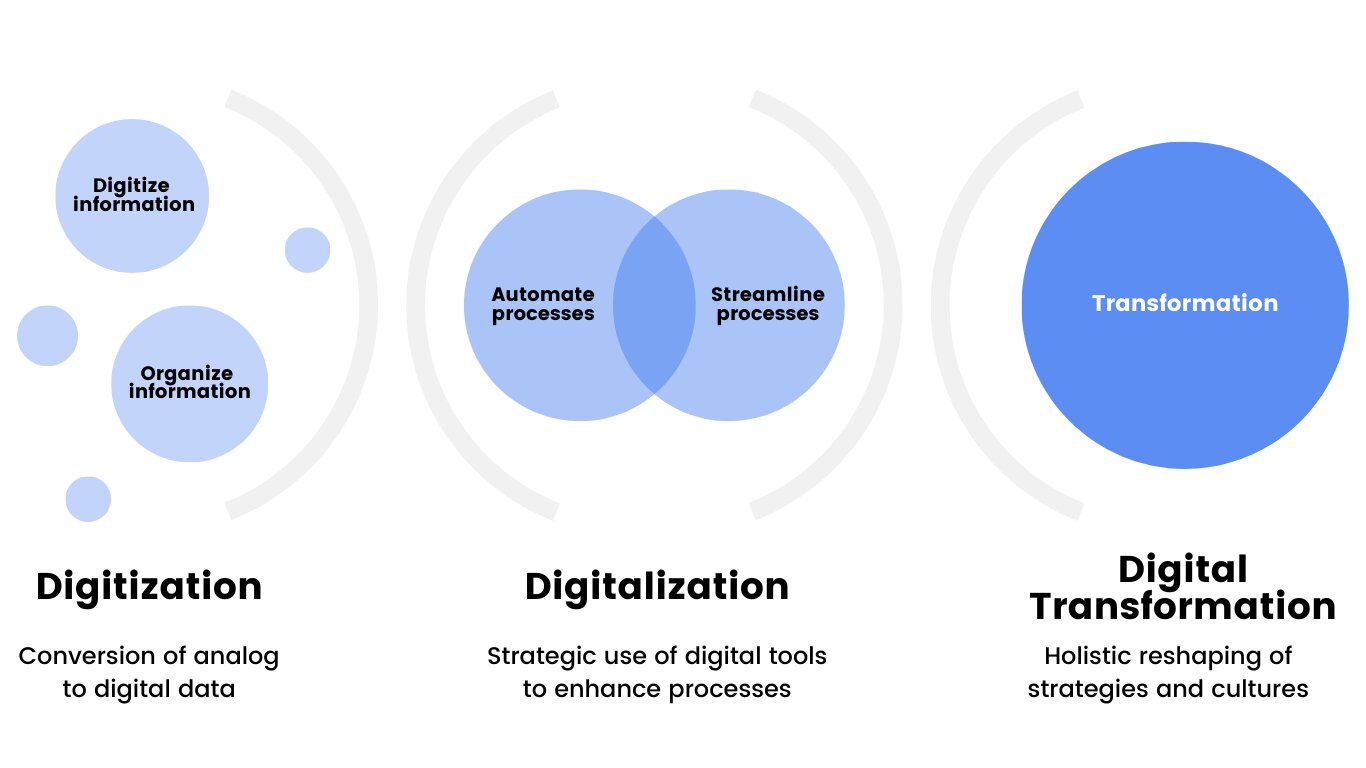
Data shows that companies prioritizing digital transformation enjoy a 1.8 times higher profitability compared to peers who don't. By clarifying these distinctions and aligning them with their goals, businesses can navigate the path to digital excellence with clarity and purpose.
Learn about 4 types of digital transformation
There's no need to mention once again the rapidly-changing business landscape. However, it wouldn't hurt to reaffirm the significance of innovation in understanding what digital transformation is all about.
McKinsey conducted two studies on the digital changes within medium and large companies, as well as the impact of these changes on their business strategies.
The contrast between the two studies is mind-blowing. In 2018, only 4% to 11% of non-tech companies were successful in digital transformation. Now, over a third of all respondents assert that technology will become a pivotal factor in shaping their company's strategy.
For your curiosity, take a look at the graph below. It illustrates how companies will implement digital transformation and what they plan to invest in. Truly insightful.
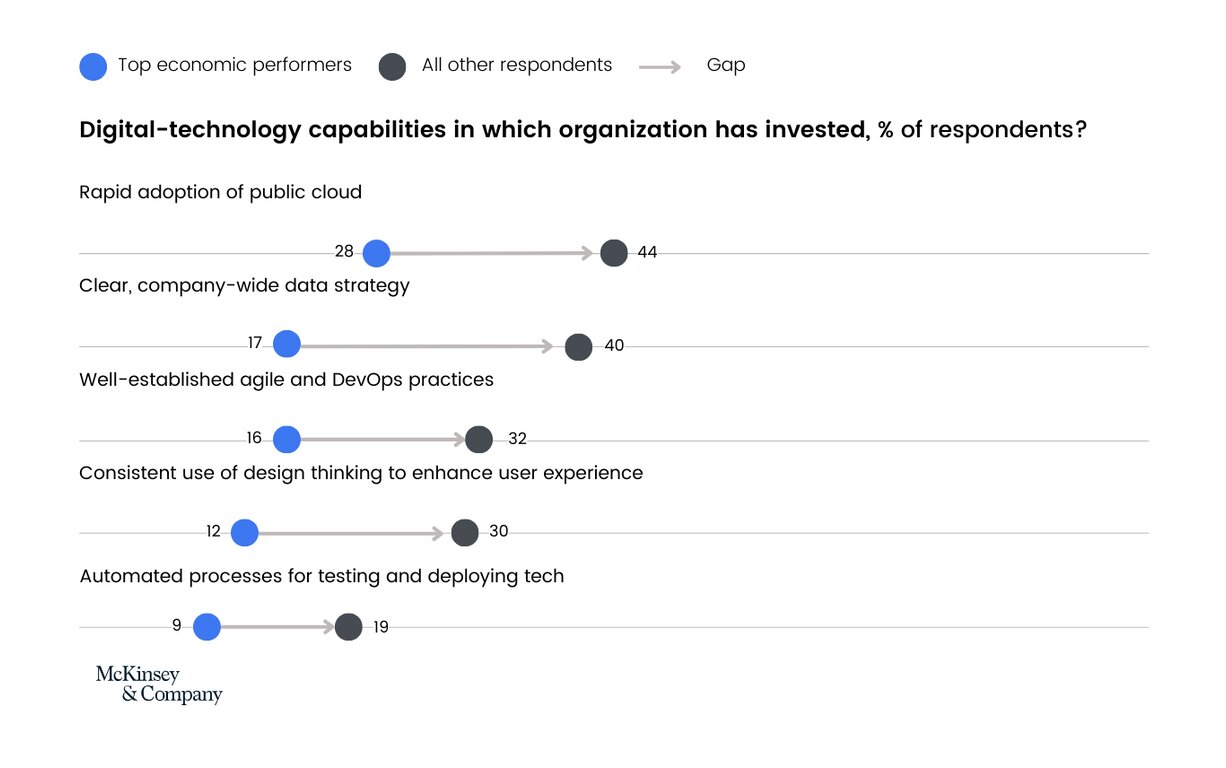
The digital landscape offers many benefits that extend far beyond operational optimization. Embracing digital transformation enhances their competitiveness, agility, and scalability, placing them on a trajectory of continued growth and innovation.
Improved Competitiveness. A report by the World Economic Forum reveals that 84% of companies that invest in digital transformation experience increased market share and improved customer satisfaction. This resonates with the fundamental truth that in a digitally driven marketplace, those who adapt thrive, while those who resist risk obsolescence. Digital transformation empowers businesses to respond adeptly to evolving customer preferences and market trends, thereby securing their competitive edge.
Enhanced Agility. McKinsey's research underscores that digitally transformed organizations can react to market changes 2.5 times faster than their less transformed counterparts. By infusing agility into processes, decision-making becomes nimble, enabling swift adjustments to seize emerging opportunities and navigate challenges with precision.

Scalability. Forbes reports that 70% of digitally mature organizations have successfully scaled their initiatives across the enterprise. Businesses can seamlessly expand their operations without traditional bottlenecks by integrating scalable digital technologies.
Data speaks louder than words. Previous passage profs that digital efforts pay off. As McKinsey experts assert, "Digital transformation is no longer a luxury; it's an imperative." The businesses that embrace this imperative are poised to thrive, fortified by enhanced competitiveness, newfound agility, and the capability to scale in ways previously unattainable.
The COVID-19 pandemic has significantly impacted the service and travel industries. That's obvi. But which other sectors have also pivoted? Many, if not all. Seriously. For instance, the banking sector.
Take a look at the Finalta benchmark by McKinsey, which monitored the progress of 80 global banks each year from 2018 to 2022. The benchmark used 50 standardized metrics, including factors like digital and mobile adoption, digital sales of banking products, the number of contact center employees, and the number of branches. They focused on two metrics – the percentage of mobile adoption among their customer base and the percentage of sales originating from digital channels – to identify the top 20 digital leaders and bottom 20 digital laggards. These two metrics are widely recognized in the industry as crucial indicators of a successful digital retail banking model.
And you know what? There are striking findings: digital leaders create a lot more shareholder value than laggards. Between 2018 and 2022, digital leaders achieved an average annual total shareholder return of 8.1% compared to 4.9% for laggards. A leader's return on pre-tax tangible equity (ROTE) increased from 15.5% in 2018 to 19.3% in 2022, while a laggard's increased from 13.6% to 15.3%. Supply chains were the most visibly exposed operational procedure. Supply chains are constantly susceptible; supply chain disruptions lasting one month or more occur every 3.7 years, according to the McKinsey Global Institute. Yet, immediately after the epidemic began, the United States abruptly reduced imports from major trading partners by about 50%. Companies were compelled to go through years or decades of supply chain change in weeks or months.
To go digital, every organization must rewire its operations. Amazon was once simply another start-up that had to invest in its technology, analytics, performance management, and talent practices over time to become an industry leader. The good news is that successful digital transitions aren't limited to tech behemoths. Established businesses of all sizes can be successful in their digital transformation efforts. Here are three instances:
Freeport-McMoRan. A copper-mining giant built and deployed an AI model at an ore-concentrating mill in Baghdad, Arizona, to unlock next-level performance. Freeport-McMoRan increased copper output without a massive capital injection by building cross-functional teams to develop and iterate on an AI model. They shifted their culture to focus on rapid iterations and continuous improvement while instituting a quarterly planning system.
Vistra. A major US power producer developed a neural network model to improve efficiency and reduce emissions. The AI model generates recommendations for operators every 30 minutes based on two years of plant data. The key to success was scaling solutions across Vistra's network using a machine-learning-operations infrastructure. A cross-functional team ensured speedy development and high-quality models.
Emirates Team New Zealand won its fourth America's Cup in 2021 with the help of an AI bot. The bot learned to sail like a pro using deep reinforcement learning, which combined sailors and data scientists to develop and train the bot with continuous feedback. The team figured out the right learning models, coached the bot, and set guardrails. The team used cloud hosting for many bots and applications to enable the required computation.
Successful digital transformation hinges on precisely orchestrating key components that drive innovation and efficiency across enterprises.
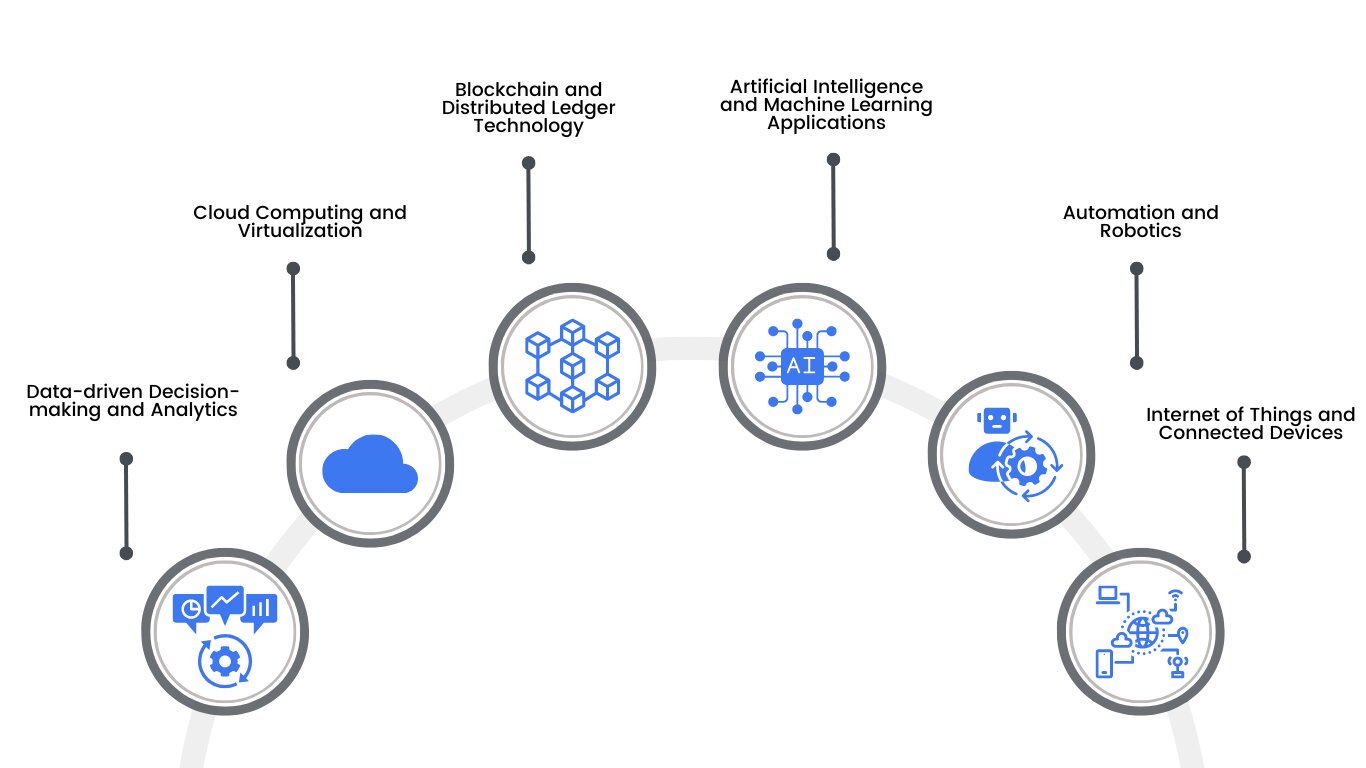
Data-driven Decision-making and Analytics. The foundation of digital transformation rests on data-driven insights. Harnessing the power of data analytics enables organizations to glean actionable intelligence, steering strategies with precision and agility.
Cloud Computing and Virtualization. Cloud technology empowers businesses to transcend physical limitations, fostering scalable operations and streamlined resource allocation. Virtualization complements this by maximizing hardware utilization and flexibility.
Internet of Things (IoT) and Connected Devices. IoT establishes a digital ecosystem of interconnected devices, enabling real-time data exchange. This connectivity enhances operational visibility and paves the way for predictive maintenance and personalized customer e-xperiences. Take a look at AjaxSystems (security ecosystem) or the more famous Cisco with its automation and connectivity sensors.
Artificial Intelligence and Machine Learning Applications. AI and ML unlock the potential of data by uncovering patterns and insights that drive informed decisions. These technologies automate tasks, optimize processes, and amplify human capabilities.
Automation and Robotics. The automation of routine tasks and intricate processes augments efficiency while reducing human error. Incorporating robotics further elevates efficiency, particularly in manufacturing and logistics.
Blockchain and Distributed Ledger Technology. Blockchain's decentralized, tamper-resistant ledger enhances transaction transparency and security, making it instrumental in supply chains, finance, and beyond. For example, web3 startups like Sol2Ink that allow effortless migration from Solidity to Polkadot’s ink!.
The sweeping wave of digital transformation has ushered in profound changes across diverse sectors, reshaping the fabric of businesses and industries. This metamorphosis is tangible in multiple dimensions, a testament to digitalization's potency as a catalyst for innovation and growth.
Enhanced Customer Experiences and Personalization. Data-driven insights drive an unparalleled understanding of customer preferences and behaviors, fostering tailor-made experiences. Starbucks' mobile app, which customizes orders and recommendations, exemplifies how digital transformation can create memorable interactions, hitting the ground running with its 10% increase in revenue.
Streamlined Operations and Increased Efficiency. Automation and digital tools optimize workflows, eliminating bottlenecks and enhancing efficiency. Amazon's fulfillment centers utilize robotics to accelerate order processing, contributing to a remarkable 40% increase in productivity. Another example is a no-name in the US but famous in Ukraine, Nova Poshta. The same tools and remarkable results.
New Business Models and Revenue Streams. Digital transformation fuels the emergence of disruptive business models. Airbnb's platform leverages digitalization to connect travelers with unique accommodations, spawning an entirely new lodging paradigm and a valuation surpassing traditional hotel chains.
Improved Collaboration and Communication. Digital tools bridge geographical gaps, enabling seamless collaboration. Slack, a communication platform, exemplifies this by transforming team dynamics, resulting in a 32% reduction in email usage among its users.
You may also remember Walmart's integration of blockchain to trace food sources has enhanced supply chain transparency, enhancing consumer trust. Another example of blockchain use is cryptocurrency payment in Ukrainian grocery stores Silpo.
Digital transformation is no longer an option but a necessity for businesses in today's dynamic world. Successful technology transformation initiatives rely on data-driven decision-making, cloud computing, IoT, AI, automation, and blockchain. Companies such as Starbucks, Amazon, Airbnb, and Walmart demonstrate the tangible benefits of embracing digitalization. Leveraging digitalization is essential for sustainable growth and success in all aspects of business.
Devico's blog offers insights and expert perspectives to help businesses confidently navigate this transformative journey.
Outsourcing to Czechia

Dec 2nd 25 - by Devico Team
Find out how much it costs to hire software developers in Czechia in 2025. Compare hourly rates, roles, and factors that impact pricing.
Outsourcing to Czechia

Nov 25th 25 - by Devico Team
Compare Czechia and Poland for software outsourcing in 2025. Discover costs, talent, infrastructure, and which country fits your project best.
Outsourcing to Czechia

Nov 18th 25 - by Devico Team
A complete guide to outsourcing software projects to Czechia, learn about costs, talent, benefits, and how to build successful partnerships in 2025.